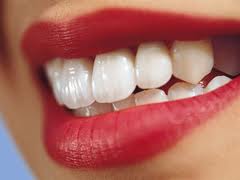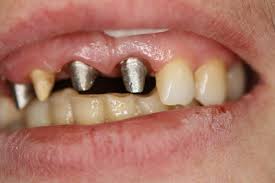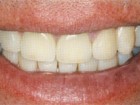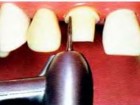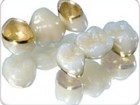Cermets
Modern prosthetics technology teeth used today in orthopedics, allows you to use a variety of materials for the manufacture of dentures, of which the most popular is cermets.
Cermet - prosthetics, the stages of which are reduced to the manufacture of teeth and bridge structures from the same material.
As the name implies, cermet prostheses are a frame made of metal, covered with a thin layer of ceramic on top. Non-metal ceramics and cermets, the difference between them in the composition.
Ceramic prosthetics
Ceramic prosthetics today makes it possible to solve the problem of their absence at any age. The advantage of such prostheses is that with their help the injured and lost teeth restore the previous function of the dentition and have an ideal appearance.
Cermets are widely used for removable and non-removable prosthetics. A removable prosthesis made of cermet is made if it is impossible to install a fixed structure.
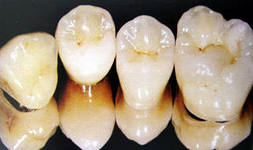
What does a ceramic-metal crown look like: rear view - see photo.
How to make metal ceramic teeth?
The doctor makes an impression of the dental structure and gives it to the dental technician. A dental technician models the frame of future crowns on it. Then the doctor tries it on the patient’s teeth.
If the frame sits well on the teeth, then ceramics are applied on top of it. Ultimately, the design is covered with glaze. Everything - the prosthesis is ready.
How to insert metal ceramic teeth
Ceramic prosthetics is a process that takes time. Installation of the prosthesis takes several minutes. But before inserting teeth from cermet, it is necessary to go through a series of procedures, visiting an orthopedic doctor.
Stages of prosthetics with metal-ceramic
- At the initial stage, teeth are prepared for prosthetics with cermet.
- If necessary, non-viable teeth are removed, teeth and gums are treated.
- Based on the examination and the budget planned by the patient, one or another type of crowns is selected and an estimate is made.
Ceramic preparation of teeth
Tooth turning for cermet is a mandatory procedure. If a bridge is placed, then the preparation of supporting teeth is necessarily performed. The preparation of the tooth under the ceramic-metal crown is made in such a way that the tooth takes a conical shape.
How to insert teeth from cermet, if only the roots are left? In this case, they restore part of the tooth crown using a pin or a stump tab.
Indications and contraindications
Ceramic metal dental crowns are installed in case of inferiority of the dental crown of real teeth or their absence.
Indications for the installation of cermets:
- Destruction of tooth crowns when it is impossible to restore them with fillings or tabs.
- Anomalies in the development of teeth that cannot be eliminated by any other means.
- Pathological abrasion of tooth enamel.
- Defects of crowns (loss of gloss, discoloration, loss of shape).
- Defects in the dentition.
- Inconsistency of existing crowns (plastic, metal, combined) and bridge prostheses with aesthetic requirements.
- To restore two or more teeth in a bridge.
- Recovery of lost chewing teeth.
Ceramics can be installed in all cases that are not a contraindication.
Contraindications for the use of cermets:
- Allergic reaction to cermets.
- Teeth with periodontal pathology.
- Pronounced convergence of teeth.
- Teeth grinding at night (bruxism).
- Defects in the dentition of a long extent.
- Teeth having a shortened crown.
- If a tooth hurts, cermet cannot be installed until it is completely cured.
Pros and cons
Due to their excellent qualities, dental crowns and bridges are very popular among the population. But no matter how good the ceramic metal teeth, the pros and cons have all kinds of materials.
Pros and cons of cermets:
- Aesthetics. Complete resemblance to real teeth in color and shape. But since the shaft present in the prosthesis does not transmit light well, this can affect the different appearance of two adjacent teeth.
- Hygiene Cermet teeth are not exposed to germs.
- Full biocompatibility. If the teeth are set correctly, then they can not affect the health of the gums.
- Strength and durability. Cermets can withstand heavy loads. If you observe oral hygiene, then the teeth and the bridge of the teeth can last more than 15 years.
- Functionality. There is no difference in eating.
- Protection of the remaining part of the tooth under the crown from the damaging effects of the aggressive environment of the oral cavity.
- The color of the teeth does not change over time.
- The price is low in comparison with non-metallic prostheses and implants.
- The cost is higher than for prosthetics with metal structures.
The service life of cermets
The service life of cermet structures depends on many factors. In order for prostheses to serve longer, it is necessary to adhere to certain rules. Attitude to them should be the same as to real teeth. No food restrictions are worth doing.
But also experiment with opening bottles, cracking nuts, bones, etc. also not necessary. If, in the process of chewing solid food, the tooth nevertheless broke off, then the prosthesis manufacturing technology was violated.
According to WHO, the service life of cermet crowns is 7-8 years.
Complications
Complications when using metal-ceramic prostheses can occur due to the side effects of the prostheses themselves, the side effects of the materials that make up the prosthesis and as a result of technical or medical errors.
Complications may occur with side effects such as:
- Changing the condition of the gingival margin and gingivitis.
- If a tooth hurts under cermet, this can signal that periodontitis has begun to develop. Usually, this happens if the crown was installed on a live tooth.
Cost
How much is cermet crown?
- You can find a cheap cermet crown for 3000 rubles, then such a design will most likely be stamped.
- A cermet crown made by a Japanese or German manufacturer will cost about 6,000 rubles per unit.
- If the crown is Belarusian or Russian, then the price will be lower - 4500 rubles.
- Cermet made of cermet for gold - platinum or gold - palladium alloys - 9000 rubles.
- The cost of a metal-ceramic crown on gold is 17,000 rubles per unit.
- It is possible to put cermet only on the front teeth, and on the side and wisdom teeth, for example, plastic.
Installation of a turnkey crown in Moscow, including diagnostics, anesthesia, tooth turning, casting a mold, manufacturing and fixing of a crown will cost 12,000 rubles.

